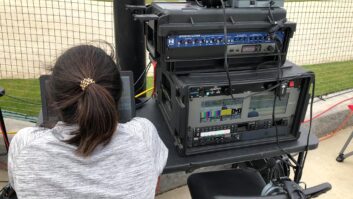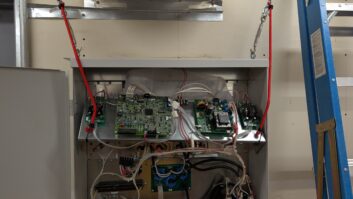
Most, if not all, engineers know how to handle a soldering iron. But there are a few folks in the industry who want to know more about those wisps of smoke they sometimes see rising from our workbenches.
FIRST THINGS FIRST
First, you need the right tools for the job. As is often the case, the amount of money you spend can vary greatly. For years, I’ve been using a Radio Shack soldering station that set me back all of $25, and it’s been very reliable. Someday, before I retire, I plan to splurge on a nice $50–60 soldering iron from Weller. I’ve seen some units costing hundreds of dollars.
They all perform the same basic function: get hot enough to melt solder. The better units have some form of temperature control, either a rheostat or a simple two-position switch to determine wattage. On the other end of the scale is your basic soldering iron without the stand or temperature control, which some of us keep in our tool bag.
Next, choose a solder with the right alloy formulation and flux. The most common alloy is 60 percent tin and 40 percent other metals, like silver or antimony. Lead has been commonly used but is being phased out.
Flux is a reducing agent that prevents oxidization and improves the chemical bond between metals. Always use rosin flux solder for electronics, never acid flux. That’s the kind plumbers use to join or “sweat” pieces of copper pipe. As the name implies, it contains an acid that etches the copper to ensure a good joint. Used on electronics, it can damage components and wear out the tip of your iron much faster.
Temperature settings are important when working with delicate components. Too much heat can damage some semiconductors. You want the iron hot enough to get solder flowing properly over the joint, but if it starts melting everything around it, you’ll want to back off on the heat.
Keep the tip clean and in good condition. This is vital. Some tips wear out faster than others, so keep a spare on hand. Most soldering stations have a spot for a damp sponge to wipe excess solder and other residue off the tip. I’ve seen engineers use a kitchen scour pad.
Eye protection when soldering is a must. Molten solder can splash, and flipping a drop into your eye is no way to spend a Saturday night!
Good ventilation is important, too. Remember, the metal alloy in solder can contain lead (especially older solder), and you don’t want to inhale that smoke. A small fan on your bench is helpful. If a fan is not available, at least try not to park your face right above your work. Wash your hands after soldering, so any residue doesn’t end up in your mouth or eyes.
Obviously, burn prevention is the rule. These tools reach about 600–800 degrees Fahrenheit. You definitely want to rest the iron somewhere safe. Soldering stations address this with a dedicated holder. Some irons come with a little folding rest to keep the heating element off the work surface. Personally, I’m not fond of these. A bump or a tug on the cord can send the iron rolling across the bench. Make sure the tip is on tight before you turn it on. I once had a loose tip fly off in the middle of a job. Thankfully, that 800-degree piece of metal didn’t land in my lap, but the burn mark in the rug was there to remind me for years!

HOT IRON
So now you’ve got your iron hot and your solder ready.
When working on a PCB, make sure the piece is planted firmly so it can’t slide around while you’re working. A Panavise or similar clamp is handy.
On the trace side of the board, the component leads will protrude through the holes in the traces. Place the tip of the iron at an angle with one side against the lead and the other against the trace. In just a few seconds everything will be hot enough to introduce the solder.
Place the tip of the solder wire on the opposite side of the lead from the tip of the iron. The solder should immediately flow around the joint.
Quickly remove the solder wire. Too much can spread beyond that trace and cause short circuits, or solder bridges to other traces.
The finished joint should look like a nice, little shiny mound of solder. If the joint looks crystalized or cracked, or you can still see the hole, this is an incomplete, or cold, joint. Apply the tip of the iron again for a few seconds to reflow the joint.
After the joint solidifies, clip off the excess wire as closely as possible. If you’re working on IC pads or very tiny components, a finer tip might be necessary.
What about when you are working with connectors or panel-mounted parts?
There are usually solder lugs or pins provided. First, strip the end of the wire just enough to make the connection. An eighth to a quarter of an inch is usually adequate. It helps, especially when working with stranded wire, to heat the exposed wire and apply a bit of solder. This tinning keeps the strands together and makes it easier to bend the wire around a lug or pin.
Putting a small bend in the end of the wire, place it in the lug. Then place the iron tip against the lug, making contact with the wire as well, and introduce the solder. As with the PCB joint, the solder should flow evenly and solidify smoothly.
Be sure to apply heat just long enough to melt the solder, but not the insulation on the wire. On XLR or D-sub connectors, the contact pins usually feature tiny cups on the soldering side. Before creating the joint, it helps to flow a bit of solder into each cup.
By the way, when working with in-line connectors, make sure to slide the connector’s outer shell on the cable before you solder the connector. Many harsh words have been uttered over the years by engineers who smiled over a fine soldering job only to have to take it apart because they forgot this step!
Speaking of which, occasionally you’ll have to remove soldered components. For this you’ll need a desoldering suction tool or desoldering braid. The braid uses the wick effect to remove solder.
Heat the joint you wish to remove until the hardened solder melts, then place the end of the braid against the tip of the iron. The softened solder should wick out of the joint and into the braid. The suction tool works by using a spring loaded plunger to create a burst of vacuum pressure to suck the molten solder away.
Sometimes, the old solder joint won’t melt right away. If this happens, introduce some fresh solder as you apply heat. The flux in the fresh solder will help break down the old joint.
As with any skill, good soldering takes practice. If it’s something you’d like to pick up, find an inexpensive iron and start by working on cable connectors. Once you get the hang of it, improve your skills on the connectors. When you’re comfortable, find a small electronic kit with a PCB and try your hand at that.
With practice and experience, you’ll find this a very useful skill to have. Happy soldering!
A version of this article originally appeared in Radio World. Curt Yengst, CSRE, is assistant engineer for WAWZ(FM) and a regular contributor to RW.







